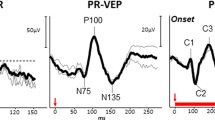Abstract
In this study we show how the Pattern ERG (PERG) can be used to distinguish between optic nerve and retinal disease. Records from eyes with RBN and delayed visual evoked responses are compared with those recorded from the normal fellow eyes. In optic nerve disease there is a selective reduction of the later negative component of the PERG. PERGs were also recorded from patients with mild diabetic retinopathy. These were divided into three groups on the basis of the delay in their Visual Evoked Potential (VEP). The amplitude of both positive and negative components of the PERG fall with increasing severity of the disease thus showing that the abnormally long delay in VEP found in some cases is due to retinal disease rather than optic nerve disease.
Similar content being viewed by others
References
Regan D (1972) Evoked potentials in psychology, sensory physiology and medicine. Chapman and Hall: London.
Arden GB (1973) The visual evoked response in ophthalmology. Proc Roy Soc Med 66: 1037–1043.
Carr RE, Siegel IM (1982) Clinical electrophysiological techniques: a practical guide for the clinician. Williams and Wilkins: Baltimore
Halliday AM (1982) Evoked Potentials in Clinical testing. Churchill-Livingstone: Edinburgh.
Arden GB, Carter RM, Hogg C, Siegel IM, Margolis S (1979) A Gold Foil electrode: extending the horizons for clinical electroretinography. Invest Ophthalmol and Vis Sci 18: 421–426.
Spekreijse H, Estevez O, van der Tweel LH (1973) Luminance responses to pattern reversal. Doc Ophthalmol Proc series, 10th ISCERG Symposium 2: 205–211.
May JG, Ralston JV, van Dyk HJL (1982) Loss in pattern elicited electroretinograms in optic nerve dysfunction. Am J Ophthalmol 93: 418–422.
Dawson W, Maida R, Rubin M (1972) Human pattern evoked retinal responses are altered by optic atrophy. Invest Ophthalmol Vis Sci 22: 796–803.
Ohta H, Tamura T, Kawasaki K, Yonemura D (1986) Negative wave in human pattern ERG and its suppression in Glaucoma. Acta Soc Ophthalmol Jpn 882–886.
Florentini A, Maffei L, Pirchio M et al. (1981) The ERG in response to alternating gratings in patients with diseases of the peripheral visual pathways. Invest Ophthalmol Vis Sci 21: 490–493.
Arden GB, Vaegan, Hogg CR (1982) Clinical and experimental evidence that the pattern electrotretinogram (PERG) is generated in more proximal retinal layers than the Focal electroretinogram (FERG). Ann NY Acad Sci 388: 580–601.
Korth H (1983) Pattern-evoked responses and luminance-evoked responses in the human electroretinogram. J Physiol (London) 337: 451–469.
Maffei L, Fiorentini A, Bisti S, Hollander H (1985) Pattern ERG in the monkey after section of the optic nerve. Exp Brain Res 59: 423–425.
Fiorentini A, Maffei L, Pirchio M, Spinelli D, Porciatti V (1982) Pattern ERG in patients with unilateral alteration of retinal ganglion cells. Doc Ophthalmol 31: 131–133.
Berninger T, Schuurmans RP (1985) Spatial tuning of the pattern ERG across temporal frequency. Doc Opthalmol 61: 17–25.
Schuurmans RP, Berninger T (1985) Luminance and contrast responses in man and cat. Doc Opthalmol 59: 187–197.
Holder GE (1987) Significance of abnormal pattern electroretinography in anterior visual pathway dysfunction. Brit J Ophthalmol 71: 166–171.
Arden GB (1986) (Letter) Uniocular recording of pattern ERG. Vis Res 26: 281–286.
Arden GB et al. (1976) Pattern electroretinograms become abnormal when background diabetic retinopathy deteriorates to a pre-proliferative stage: Possible use as a screening test. Brit J Ophthalmol 70: 330–335.
Bresnick GH, Groo A, Palta M (1984) Electroretinographic oscillatory potentials predict progression of diabetic retinopathy. Arch Ophthalmol 102: 1307–1311.
Weinstein GW, Arden GB, Hitchings RA, Ryan S (l 988) The PERG in Ocular Hypertension and Glaucoma. Arch Ophthalmol (in press)
Yanko L, Ticho U, Ivry M (1972) Optic nerve involvement in diabetics. Acta Ophthal 50: 556–664.
Editorial (1987) Clinical electrophysiology can pinpoint pathology in the visual pathway. Lancet 961–2.
Author information
Authors and Affiliations
Rights and permissions
About this article
Cite this article
Ryan, S., Arden, G.B. Electrophysiological discrimination between retinal and optic nerve disorders. Doc Ophthalmol 68, 247–255 (1988). https://doi.org/10.1007/BF00156431
Issue Date:
DOI: https://doi.org/10.1007/BF00156431




